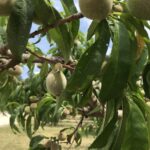Thin Your Peaches Like a Pro!
go.ncsu.edu/readext?794762
en Español / em Português
El inglés es el idioma de control de esta página. En la medida en que haya algún conflicto entre la traducción al inglés y la traducción, el inglés prevalece.
Al hacer clic en el enlace de traducción se activa un servicio de traducción gratuito para convertir la página al español. Al igual que con cualquier traducción por Internet, la conversión no es sensible al contexto y puede que no traduzca el texto en su significado original. NC State Extension no garantiza la exactitud del texto traducido. Por favor, tenga en cuenta que algunas aplicaciones y/o servicios pueden no funcionar como se espera cuando se traducen.
Português
Inglês é o idioma de controle desta página. Na medida que haja algum conflito entre o texto original em Inglês e a tradução, o Inglês prevalece.
Ao clicar no link de tradução, um serviço gratuito de tradução será ativado para converter a página para o Português. Como em qualquer tradução pela internet, a conversão não é sensivel ao contexto e pode não ocorrer a tradução para o significado orginal. O serviço de Extensão da Carolina do Norte (NC State Extension) não garante a exatidão do texto traduzido. Por favor, observe que algumas funções ou serviços podem não funcionar como esperado após a tradução.
English
English is the controlling language of this page. To the extent there is any conflict between the English text and the translation, English controls.
Clicking on the translation link activates a free translation service to convert the page to Spanish. As with any Internet translation, the conversion is not context-sensitive and may not translate the text to its original meaning. NC State Extension does not guarantee the accuracy of the translated text. Please note that some applications and/or services may not function as expected when translated.
Collapse ▲Does your peach tree yield small, flavorless fruit? Try thinning your peaches for a better quality yield. When we don’t thin our peaches, each peach has to compete against its friends for nutrients and water. Thinning out the weaker or damaged peaches after the “shuck split” stage will allow more of the nutrients to go to fewer fruit, thereby improving the quality of individual fruits.
- smaller peach atop a larger peach
Thinning starts with pruning in the winter months before there are blooms on the tree. You’ll probably see little buds on the new growth of the tree. The new growth is indicated by the reddish color of the wood. Each place you see more than one bud, there will be a bloom and ultimately a peach.
Once your peach tree is in full bloom, you can continue to thin. At this point, there is still a chance of a late freeze, so you’ll want to proceed carefully and not remove too many blooms. A late freeze will naturally thin out some of your blooms/fruit. You can tell a freeze damaged fruit from a non freeze damaged fruit by slicing it through the center and checking the color of the pit. However, after the threat of freezing has passed, and you start to see little baby peaches, you’ll want to get thinning.
Thinning for peaches is simply done by plucking the baby fruit from the tree. Select peaches that look very small compared to others to thin out first. Then you’ll want to thin the peaches to about three fruit per 12 inches of branch. Consider how big the peach will become and make sure it has enough room to grow to that size without being squished between its friends.
Lastly, when you’re thinning, you can toss the plucked fruit into a bucket to discard or use for compost, or you can simply toss them on the ground around the base of the tree and allow them to whither away and decompose naturally.




